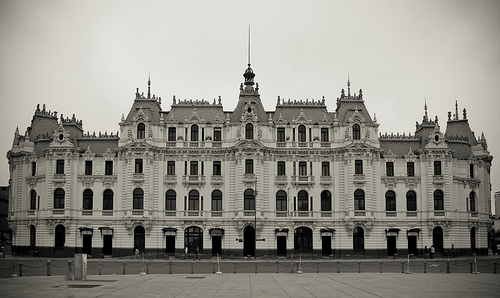Rímac District on:
[Wikipedia]
[Google]
[Amazon]
Rímac is a district in the

Consulta a Nivel de Centro Poblado
Retrieved May 29, 2008. * Caqueta *
www.munirimac.gob.pe Official website
1.40 Gigapixel Image of Lima
{{DEFAULTSORT:Rimac District Districts of Lima
Lima Province
Lima Province is located in the central coast of Peru and is the only province in the country not belonging to any of the twenty-five regions. Its capital is Lima, which is also the nation's capital.
Despite its small area, this province is the ...
, Peru
, image_flag = Flag of Peru.svg
, image_coat = Escudo nacional del Perú.svg
, other_symbol = Great Seal of the State
, other_symbol_type = Seal (emblem), National seal
, national_motto = "Fi ...
. It lies directly to the north of downtown Lima, to which it is connected by six bridges over the Rímac River
The Rímac River is located in western Peru and is the most important source of potable water for the Lima and Callao Metropolitan Area.
The river is part of the Pacific watershed and has a length of 204 km. The river begins in the highland ...
. The district also borders the Independencia, San Martín de Porres, and San Juan de Lurigancho districts. Vestiges of Lima's colonial heyday remain today in an area of the Rímac district known as the Historic centre of Lima
Located principally in the city centre or Cercado de Lima and Rímac areas, the Historic Centre of Lima is among the most important tourist destinations in Peru.
Foundation
The city of Lima, the capital of Peru, was founded by Francisco Pi ...
, which was declared a UNESCO World Heritage Site
A World Heritage Site is a landmark or area with legal protection by an international convention administered by the United Nations Educational, Scientific and Cultural Organization (UNESCO). World Heritage Sites are designated by UNESCO for ...
in 1988.
Downtown Rímac District has, like its southern counterpart, its eastern and western sides divided by Jirón Trujillo, which connects to Lima District's Jirón de la Unión
The Jirón de la Unión, or Union Street, is a pedestrian street located in the Historic Centre of Lima, part of the capital of Peru. For many decades it was the most important boulevards of the city, often described as the most aristocratic, wher ...
through the '' Puente de Piedra'', the oldest bridge in the whole city. Rímac's East side features the Plaza de Acho
The Plaza de Toros de Acho is the premier bullring in Lima, Peru. Located beside the historical center of the Rímac District, the plaza is classified as a national historic monument. It is the oldest bullring in the Americas and the second-oldest ...
, the most famous bullfighting
Bullfighting is a physical contest that involves a bullfighter attempting to subdue, immobilize, or kill a bull, usually according to a set of rules, guidelines, or cultural expectations.
There are several variations, including some forms w ...
arena in South America
South America is a continent entirely in the Western Hemisphere and mostly in the Southern Hemisphere, with a relatively small portion in the Northern Hemisphere at the northern tip of the continent. It can also be described as the souther ...
and one of the most well known in the world.
Looking directly from Puente Ricardo Palma on downtown Lima district's East side can be seen a large building with the logo of Cristal beer, one of two famous Peruvian brands. This was the main brewery until the Backus company moved operations to Ate in the 1990s.
North of the plant goes the Alameda de los Descalzos, a short boulevard
A boulevard is a type of broad avenue planted with rows of trees, or in parts of North America, any urban highway.
Boulevards were originally circumferential roads following the line of former city walls.
In American usage, boulevards may b ...
with a large planted median leading into the Convento de los Descalzos (Discalced Monks convent). Built in the 18th century by the Spanish
Spanish might refer to:
* Items from or related to Spain:
** Spaniards are a nation and ethnic group indigenous to Spain
**Spanish language, spoken in Spain and many Latin American countries
**Spanish cuisine
Other places
* Spanish, Ontario, Ca ...
colonial government, it is one of the best features in this lower-middle-class district.
Northern Rímac, or Amancaes, once romanticized in ballads as "La Flor de Amancaes", a hilly prairie, is now overrun with '' pueblos jóvenes'' (shanty towns). The Cerro San Cristóbal, which is the highest point in the Lima Province, is located in the district.
Boundaries
* North: Independencia * East: San Juan de Lurigancho * South: Downtown Lima * West: San Martín de Porres
Urban areas
As of 1993, Rímac is divided into the following urban areas:INEIConsulta a Nivel de Centro Poblado
Retrieved May 29, 2008. * Caqueta *
Alameda de los Descalzos
An alameda is a street or path lined with trees () and may refer to:
Places Canada
*Alameda, Saskatchewan, town in Saskatchewan
**Grant Devine Dam, formerly ''Alameda Dam'', a dam and reservoir in southern Saskatchewan
Chile
* Alameda (Santiag ...
* Cerro Palomares
* Ciudad y Campo
* El Bosque
* El Manzano
* Huascarán
* Huerta Guinea
* La Florida
* La Huerta
* Las Totoritas
* Leoncio Prado
* Perricholi
* Rímac
* Santa Candelaria
* Santa Rosa
* Ventura Rossi
* Villacampa
Festivities
* Señor Crucificado del RímacSee also
* Administrative divisions of PeruReferences
External links
*www.munirimac.gob.pe Official website
1.40 Gigapixel Image of Lima
{{DEFAULTSORT:Rimac District Districts of Lima